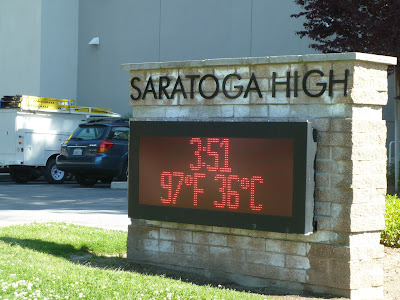Go, riders!
We now can say at least one thing about this training season: We've trained in just about every type of weather that it's possible to have during the event in June. Saturday's group of 32 intrepid cyclists set out on a 100-mile journey that became far, far tougher than planned due to the sudden heat wave that hit the area.
Many finished the entire route, some did not, and others didn't plan to do so anyway, but everyone got some helpful -- if brutal -- lessons on riding in extreme heat. The official high in San Jose on Saturday was "only" 91 degrees, but it was certainly a lot warmer along much of our route, and the hours of direct exposure to the sun reminded us that heat can be a very dangerous risk, both physically and mentally, to the endurance cyclist.
To answer the pressing question: Yes, it can get this hot during the event in June. Not every year, but temperatures in the 90s are a common occurrence, especially on Days 2 and 3. And because so much of the route for these two days is rural with few services except the official ALC stops, there usually won't be an air-conditioned Starbucks where you can seek shelter.
I'm by no means an expert on heat-related health issues, and the Internet is full of "experts" who may or may not have useful advice. But a few things stood out during our ride:
-- Disorientation is a very important warning sign that you must not ignore. Thinking clearly is essential on any ride. When the conditions are especially challenging, this is even more important. If you stop being fully aware of your surroundings (if, for example, you fail to notice a stop sign), that's the signal to stop and take a break right now. Not being aware of other traffic or other cyclists can be extremely dangerous.
-- Dehydration can happen more quickly than you might think. Your fluid intake might have been three or four times (or even more) your usual. Water alone isn't sufficient; you were sweating huge quantities of salt that need to be replaced. On the event, I often enjoy the small bags of salted nuts that are available at most rest stops. Electrolyte tablets are another popular option. If your stomach can tolerate electrolyte drinks (the event this year will serve free Gatorade, not Powerade, all week), those also can work.
-- Reduce your pace in the heat. Overexerting your heart can be especially dangerous in oppressive heat. More than ever, it's vital that you find your "happy gear" and pedal at a rate you can sustain comfortably without having to stop every mile or two.
On very hot days in past years, I've often carried a small 2-ounce spray bottle with me and filled it with water. A quick spritz to the face provides much-needed short-term relief, especially when coupled with forward motion. My bottle broke last year (another 99-cent quality purchase!), and I had not yet replaced it this year. I know one thing that's on my shopping list for this week. Instead, I was pouring bottles of water over my head; this produced a similar result, albeit with a bit more mess ... and the salt dripping down from my forehead proceeded to get stuck on my sunglasses.
If you ended your ride earlier than you hoped, then congratulations on making the right call and doing the right thing. There's no honor in injuring yourself just so you can say you finished a ride. And the type of heat that we experienced can affect any cyclist regardless of training or experience, so don't think that stopping early was any type of failure. Quite the opposite!
What's next? If one century ride wasn't enough, we've got two more coming up. On May 5, we're heading to Gilroy and back on a 113-mile ride that's on an almost all-new route this year. We'll visit the eastern foothills on much of the Tierra Bella route, and then we'll head back north around the Chesbro and Calero reservoirs -- where strong afternoon headwinds are less likely than what we've experienced on past Gilroy rides. The climbing in the middle is somewhat challenging, but the rest of the day is somewhat mellow. The first 40 miles are practically flat, and there are essentially only three turns in the first 30 miles. (The route sheet even fits on a single 8.5" by 11" sheet!) Find out more and RSVP here.
Alas, we have no more free bagels this season. Our meet times are now so early -- 6:30 for our next ride -- that the local shops won't be open in time.
And don't forget the fifth annual Altamont Pass Double Metric on May 19. This 125-mile ride has become an ALC tradition, and every year's ride ends up being epic in one way or another. We're on the same weekend as the Jonathan Pon two-day ride, so I'm aware that some of our regulars won't be able to make it, but if you're available, please join us for an incredible day. Details and RSVP are here. Remember that you must ride at least one other century before May 19 to qualify for Altamont Pass; this is to make sure such a big mileage jump won't cause problems for you so close to the event.
Congratulations and thanks to everyone for another epic day, and thank you for being part of AIDS/LifeCycle.
